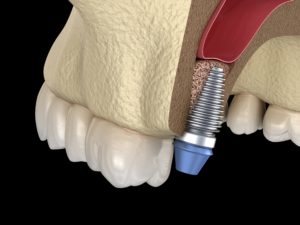Do I Need Bone Grafting for Dental Implants?
February 23, 2020
 If you’re among the 120 million Americans who have lost 1 or more teeth, you can enjoy a close replica of your natural smile with dental implants. Unlike any other dental prosthetic, they recreate the entire tooth structure, including the root. As a result, you’ll require an oral surgery to insert the post into your jawbone. The long-term success of dental implants requires your jaw to properly fuse to the post to support it. To give your new smile the foundation it needs to thrive, your dentist may recommend a bone graft.
If you’re among the 120 million Americans who have lost 1 or more teeth, you can enjoy a close replica of your natural smile with dental implants. Unlike any other dental prosthetic, they recreate the entire tooth structure, including the root. As a result, you’ll require an oral surgery to insert the post into your jawbone. The long-term success of dental implants requires your jaw to properly fuse to the post to support it. To give your new smile the foundation it needs to thrive, your dentist may recommend a bone graft.
How Do Dental Implants Work?
A titanium implant post is surgically placed into your jawbone to act as a new root. This stimulates your jaw to encourage new bone growth. Through a process called osseointegration, your bone will fuse to the post, allowing it to stay in place forever with the right aftercare, like maintaining your oral hygiene.
After your jaw has healed, an abutment is connected to the post to attach your restoration. With your jawbone properly supporting the implant, your new smile has over a 95% success rate.
What is a Bone Graft?
A graft uses bone from another area of your body or from a donor to add thickness to your weakened jaw. This restores the integrity of your jaw to ensure it can support the post long-term. Although it adds another step to your treatment plan, it’s essential to give your new smile the support it needs.
Why Do I Need a Bone Graft?
Unfortunately, if you’ve lost bone density in your jaw from infection or untreated tooth loss, you aren’t a candidate for dental implants until after you’ve had the issue corrected. In some cases, a bone graft is used along with a sinus augmentation (lift) to create enough space between the implant post and the maxillary sinuses located on either side of your nose. Placing the post without enhancing the thickness of your bone will ultimately lead to dental implant failure.
During your initial consultation, your dentist performs a comprehensive consultation to determine if bone grafting is necessary using advanced technology. 3D X-rays are widely used in dentistry to see more details than what’s possible using traditional imaging equipment.
Quick, painless scans are taken of the oral structures to create a virtual tour of your mouth. The scans integrate with state-of-the-art software to show every dimension of your jaw. Your dentist can view the thickness of your bone to determine if it can adequately support your dental implant.
Enhance Your Jawbone
If you’ve lost density in your jaw, you can still replace your missing teeth with dental implants. Bone grafting will give your restoration the support it needs.
About Dr. Patrick Crowley
Dr. Patrick Crowley earned his dental degree and went on to complete an AEGD residency program. Because of his qualifications and training, he’s an active member of various dental organizations, including the American Dental Association and the Academy of General Dentistry. If you are ready to replace your missing teeth, Dr. Crowley can perform the comprehensive treatment plan you need. Contact our office today to see if dental implants are right for you.
No Comments
No comments yet.
RSS feed for comments on this post.
Sorry, the comment form is closed at this time.
